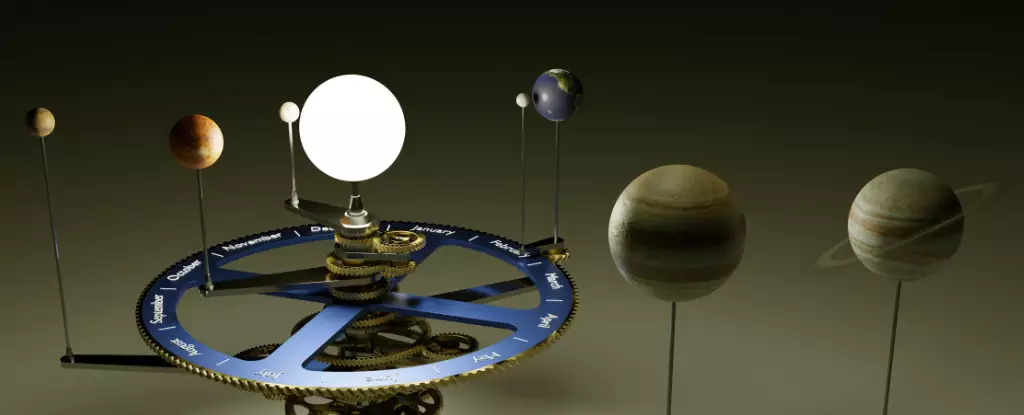In the ever-evolving tapestry of our night sky, a rare spectacle awaits avid sky watchers. The celestial lineup of planets is particularly captivating in early 2025, as Mercury, the elusive swift planet, joins the ranks of its more prominent companions. For those who relish the marvels of astronomy, this unique opportunity offers not only an engaging pursuit but also a renewed appreciation for the cosmic ballet of our Solar System.
January 2025 will go down in the annals of astronomy as a month where all observable planets align, giving rise to a remarkable sight since the last conjunction of Jupiter and Saturn in December 2020. The absence of Mercury has sometimes thwarted the completeness of this phenomenon, but its recent reappearance brings an exciting twist to the celestial choreography.
What should observers expect as February unfolds? Right after the solar conjunction on February 9, Mercury emerges in the western sky, shortly after sunset, allowing enthusiasts to spot this fleet-footed planet before the setting sun diminishes visibility. For those who have yet to view Mercury, this moment is particularly poignant, a landing on your astronomical bucket list, if you will. Observers can use the brilliant light of Venus as a beacon to locate Mercury, which will be positioned just north of Saturn on February 25.
But that’s merely the beginning. As the month progresses into March, the celestial drama amplifies—especially with the waxing crescent Moon poised to occult Mercury on March 1 for those in the Pacific regions. Knowing this helps accentuate how easily some astronomical events can be overlooked despite their proximity.
In a thrilling cosmic chase, both Venus and Mercury will continue hurtling towards inferior conjunction, a moment when they pass unobserved behind the Sun. This significant event will occur within a day of each other on March 23 and 24, providing an ideal opportunity for those passionate about astronomical phenomena to observe the fleeting beauty of a slender crescent Moon. It’s worth noting, again, that spotting Venus just before this event can be quite challenging, yet the rewards are abundant for those who embrace the challenge.
Adding context, history reminds us of the notable instances when celestial bodies drew public attention—witnessing Venus in the daytime during the second inauguration of Abraham Lincoln is an extraordinary example, encapsulating how mesmerizing and culturally impactful planetary observations can be.
As anticipation builds around the more fleeting planets, Mars nevertheless holds its own significance in the lineup. Following its notable opposition in January, Mars shines brightly in the constellation Gemini, creating a visual feast worthy of admiration. This vibrant red planet will meet the waxing gibbous Moon on March 9, captivating stargazers preparing to embark on their observational journey.
Mars’s prominence speaks to a shift in interest as NASA actively pursues exploration of the Red Planet through its ESCAPADE mission. Such ventures not only contribute to our understanding of Mars but also fuel excitement about the untapped potential of our Solar System.
Now, we shift our focus to the often-overlooked giants of our planetary ensemble. Saturn, a classic beauty with its iconic rings, will linger low in the evening glow, challenging astronomers. Observation requires effort, as even with the aid of binoculars, it may be difficult to discern Saturn amidst the dimming light. Nevertheless, spotting this planet as it edges nearer to solar conjunction, with its rings appearing edge-on, is a rewarding undertaking for determined sky watchers.
The icy giants of Uranus and Neptune provide additional opportunities for exploration. Both planets present challenges, with Uranus appearing as a faint light in Taurus, and Neptune hiding low in the horizon murk. The pursuit to witness these outer worlds is where the strength of patience and keen observation truly shines for amateur astronomers.
As March approaches, the thrill intensifies with the announcement of two significant eclipses. On March 29, sky watchers can look forward to a partial solar eclipse while the moon will showcase a total lunar eclipse on April 14. These astronomical displays not only mark a potential high point in skywatching for 2025 but also ignite spontaneous gatherings—public or personal—to celebrate the spectacle of the universe.
These planetary exhibitions remind us that the night sky is more than simply darkness sprinkled with stars; it is a complex realm of motion and beauty, beckoning us to partake in its wonders. So gather your binoculars, prepare your telescope, and embrace the ephemeral joy of the cosmos as you embark on your planetary quest. May the skies be clear, lending their brilliance to your observations and imparting a deeper connection to the universe that surrounds us.

